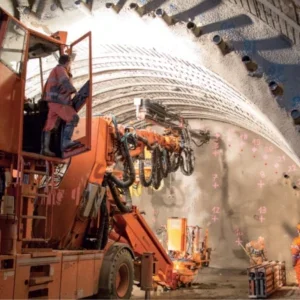Tunnel Waterproofing is one of the most demanding and challenging sectors of the tunnelling industry.
Waterproofing systems are faced with very strict requirements regarding durability, exposure, sustainability, and stress conditions, which demand well-thought out construction methods and sequences for ease of application and total cost management.
For waterproofing in tunnels or underground structures, it is important to consider the entire system rather than the individual waterproofing layers. Just like there are many different methods of constructing a tunnel, the waterproofing solution should be designed to fit specific project requirements and expected jobsite conditions.
Waterproofing Basics
The waterproofing membrane relies on a series of primary and secondary components that need to be compatible and applied in the correct sequence.
- The basic support is the surface onto which the functional layers of the proofing system are installed.
- The compensation layer, which makes up for uneven substrates, prevents damage to the waterproofing membrane.
- The drainage element collects and disposes of water on the rear side of the waterproof layer; usually consisting of corrugated hoses with micro-slots.
- The sealing element or impermeable layer generally includes a waterproof membrane, with a thickness of no less than 2mm, applied in a single or double layer depending on the required technological solution.
- The protection layer separates and protects the waterproof membrane from the concrete casting filling material and consists of a synthetic or non-woven geotextile liner.
- The partitioning element divides surfaces into sections to locate leaks.
- The injection and control element enables the integrity of the sealed surfaces and any resins injected into partitioned sectors to be checked.
A design should consider the final configuration, sequence, method of attachment to the structure, and means and methods of supporting the membrane, either externally or internally. It is vital to not puncture or injure the membrane and prevent sagging or loss of contact with the concrete structure.
Types Of Systems
There are numerous waterproofing systems available in the marketplace, including liquid, panel, sheet membranes, epoxy, sprayed, and hybrid.
Conventional waterproofing with sheets is a well-known and accepted technology. It’s a quick method to apply to flat surfaces and a preferred option for areas of high hydrostatic pressure. This method requires installation and welding with precision and can only be used for noncomplicated geometries. Leakage repair is a challenge and might require compartmentalisation.
Spray-applied waterproofing is relatively easy to install and has no problems with complex geometry. It can be applied with high rates (~150m2/h vs. ~25m2/h for sheet membranes), is easy to repair in cases of water ingress, and requires no compartmentalisation. This method can bond to both the primary and secondary linings. This offers maintenance and repair benefits by preventing the movement of water either behind or, should it be breached, in front of the membrane.
Hybrid systems, such as waterproof concrete, are a blend of additives and Portland cement and aggregates. The additives, particularly Calcium stearate, reduce the pore size of the concrete to prevent the passage of the water molecule through the coating, while allowing water vapour to pass. However, the term waterproof concrete is a misnomer as concrete can be made water resistant but not waterproof.
Preventing Leakage
Cold joints and penetrations are the most common cause of leakage in an underground structure. The lack of proper detailing and installation of the correct gaskets or waterstops in the structure causes groundwater infiltration.
The traditional waterstop for concrete cold joints is the dumbbell waterstop made of vinyl, PVC, or rubber. This is partially placed in the primary pour and held in position in the subsequent pour. This placement across the joint provides a barrier to the inflow of water.
An alternative to the traditional waterstop at cold joints is the use of swelling rubber, which is also used for penetrations. The swelling rubber is a polymerised rubber that swells ~300 per cent when in contact with water.
Summary Recommendations
- The system must accommodate the anticipated movement of the structure.
- Membranes in urban environments must be resistant to hydrocarbon, sulfates, and sulfide attack.
- Any membrane material used must comply with current federal, state, and local standards regarding flammability and toxicity.
- The waterproofing system should have a good history and record of accomplishment in similar installations.
- All sheet membrane systems must compartmentalize the membrane around the entire structure to provide areas for sealing future leaks in the membrane by methods like chemical grouting.
- During the initial stages of grouting, a manufacturer’s representative must be on-site to advise the contractor on the proper use and application of their material.






